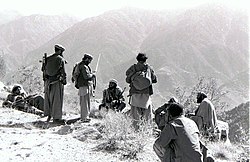Portal:Afghanistan
The Afghanistan Portal
Afghanistan, officially the Islamic Emirate of Afghanistan, is a landlocked country located at the crossroads of Central Asia and South Asia. Referred to as the Heart of Asia, it is bordered by Pakistan to the east and south, Iran to the west, Turkmenistan to the northwest, Uzbekistan to the north, Tajikistan to the northeast, and China to the northeast and east. Occupying 652,864 square kilometers (252,072 sq mi) of land, the country is predominantly mountainous with plains in the north and the southwest, which are separated by the Hindu Kush mountain range. Kabul is the country's largest city and serves as its capital. According to the World Population review, , Afghanistan's population is 43 million. The National Statistics Information Authority of Afghanistan estimated the population to be 32.9 million . Zahir Shah was overthrown in 1973, following which the Republic of Afghanistan was established.
Afghanistan is rich in natural resources, including Organization of Islamic Cooperation. Due to the effects of war in recent decades, the country has dealt with high levels of terrorism, poverty, and child malnutrition. Afghanistan remains among the world's least developed countries, ranking 180th in the Human Development Index. Afghanistan's gross domestic product (GDP) is $81 billion by purchasing power parity and $20.1 billion by nominal values. Per capita, its GDP is amongst the lowest of any country . (Full article... )
Selected article - 
The Soviet–Afghan War was a protracted armed conflict fought in the Soviet-controlled Democratic Republic of Afghanistan (DRA) from 1979 to 1989. The war was a major conflict of the Cold War as it saw extensive fighting between the DRA, the Soviet Union and allied paramilitary groups against the Afghan mujahideen and their allied foreign fighters. While the mujahideen were backed by various countries and organizations, the majority of their support came from Pakistan, the United States (as part of Operation Cyclone), the United Kingdom, China, Iran, and the Arab states of the Persian Gulf. The involvement of the foreign powers made the war a proxy war between the United States and the Soviet Union. Combat took place throughout the 1980s, mostly in the Afghan countryside. The war resulted in the deaths of approximately 3,000,000 Afghans, while millions more fled from the country as refugees; most externally displaced Afghans sought refuge in Pakistan and in Iran. Approximately 6.5% to 11.5% of Afghanistan's erstwhile population of 13.5 million people (per the 1979 census) is estimated to have been killed over the course of the conflict. The Soviet–Afghan War caused grave destruction throughout Afghanistan and has also been cited by scholars as a significant factor that contributed to the dissolution of the Soviet Union, formally ending the Cold War. The genesis of the conflict started in March 1979, when the leadership of the Soviet Union were faced with the worsening situation. There had been a violent uprising in Herat, where a number of Soviet citizens who had been sent as military advisers were executed with the situation not being adequately contained by the PDPA. The PDPA were aware that they were not able to subdue the uprising by themselves and asked for urgent Soviet military assistance to help quell the situation. They repeatedly asked and in 1979 there were over 20 request sent. In one telephone call between Afghan Prime Minister Taraki and Soviet Premier Alexei Kosygin advice is given to use local industrial workers in the Herat province as there would not be troops sent, apparently on the belief that these workers would be supporters of the Afghan Soviet Government. This was discussed further in the Soviet Union with a wide range of views both wanting to ensure that Afghanistan remained Communist, and those concerned that the war would escalate. Eventually, a compromise was reached to sent military aid, but not troops. (Full article...)
Did you know? -
General images -The following are images from various Afghanistan-related articles on Wikipedia.
Related portalsReligions in Afghanistan Neighboring countries Other countries Selected picture - Tulipa gesneriana, the national flower of Afghanistan
Topics | ||||||
























































